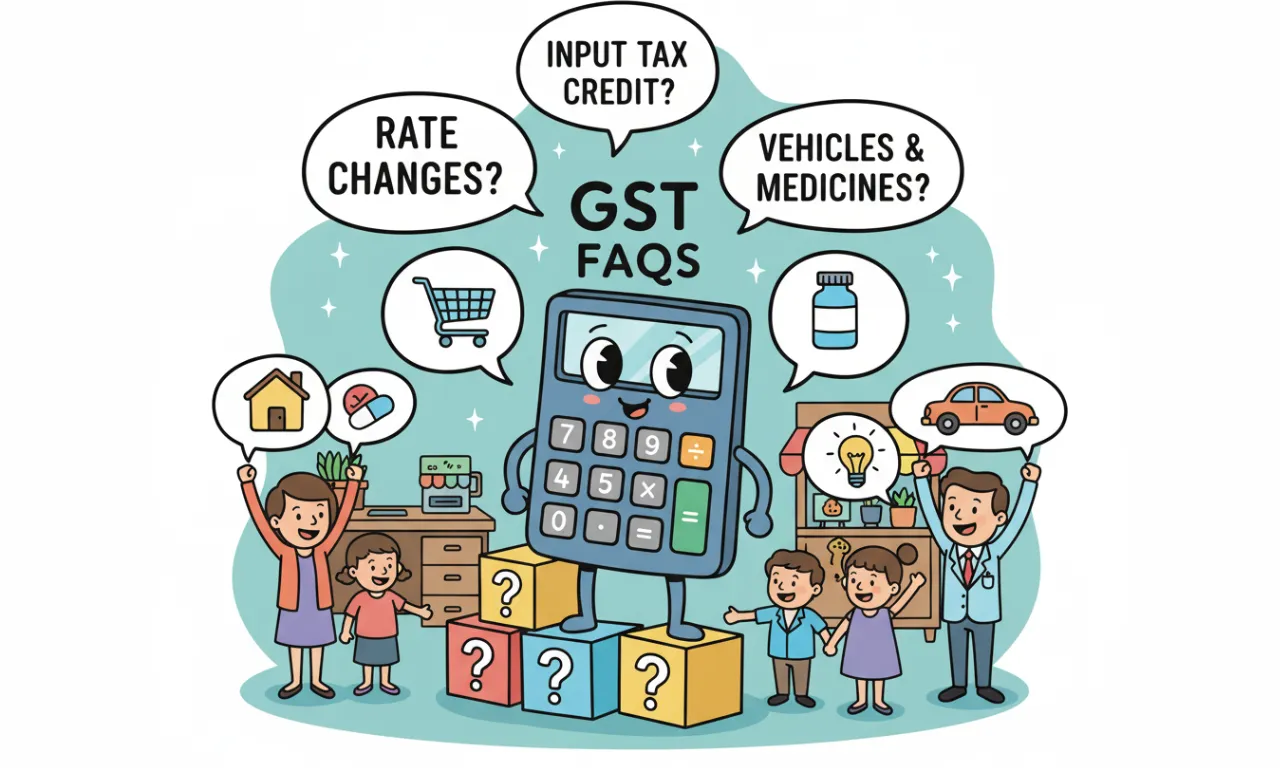- GST rate changes starting from 22nd September 2025 will affect many goods and services, except some tobacco products.
- Key updates include lower GST on small cars, farm machinery, medicines, and renewable energy equipment; a special 40% rate on luxury and sin goods.
- New GST rules explain how to use input tax credit, invoicing deadlines, and dual rate choices for passenger and goods transport services.
Goods and Services Tax (GST) Rate Revision coming into effect in September 2025 brings wide-ranging changes to GST rates across many sectors. This update covers vehicles, medicines, food items, transportation, and more, aiming to simplify the tax system and support different industries. If you want to know how these changes affect your business or daily shopping, this FAQ guide will help you understand the new GST rules clearly.
When and Where GST Rate Changes Apply
The new GST rates will start from 22nd September 2025, based on the GST Council’s 56th meeting decisions. These changes cover most goods and services except certain tobacco products like pan masala, cigarettes, chewing tobacco (zarda), unprocessed tobacco, and beedi, which will keep their current rates and compensation cess until further notice.
The registration threshold under the CGST Act, 2017 for goods remains the same. The official rate notification will be available on the Central Board of Indirect Taxes and Customs (CBIC) website.
Main GST Rate Changes on Goods and Services
The revision adjusts GST rates to keep similar goods and services taxed fairly, reduce tax disputes, and support sectors like farming and healthcare.
How GST Rates Apply to Supplies and Invoices
If goods or services were supplied before 22nd September 2025 but invoiced later, GST liability depends on the time of supply rules under Section 14 of the CGST Act, 2017:
- If payment is received after the rate change, the time of supply is the earlier of payment receipt or invoice date.
- If payment was received before the rate change, the time of supply is the payment date.
Advance payments will be taxed based on these time of supply rules.
Input Tax Credit (ITC) Rules After GST Rate Revision
Input Tax Credit for purchases made before the rate change stays valid at the original rate. Registered persons can keep using ITC earned at higher rates to pay their output tax. However, for supplies exempted after 22nd September 2025, ITC reversal is required as per CGST Act rules.
Refunds for accumulated ITC due to inverted duty structure are still available under current rules, with process improvements to speed up refunds.
GST Rates on Vehicles and Transportation Services
| Vehicle/Service Type | GST Rate | Notes |
|---|---|---|
| Small Cars (Petrol/LPG/CNG up to 1200 cc, Diesel up to 1500 cc, length ≤ 4000 mm) | 18% | Reduced from 28% |
| Mid-size and Large Cars (Engine >1500 cc or length >4000 mm, including SUVs, MUVs) | 40% | No compensation cess; special rate |
| Three-wheelers | 18% | Reduced from 28% |
| Buses (10+ persons including driver) | 18% | Reduced from 28% |
| Ambulances (factory-fitted) | 18% | Reduced from 28% |
| Goods Transport Vehicles (Lorries, Trucks) | 18% | Reduced from 28% |
| Motorcycles up to 350 cc | 18% | Includes 350 cc motorcycles |
| Motorcycles exceeding 350 cc | 40% | Special rate |
| Bicycles and parts | 5% | Reduced from 12% |
GST Rate Changes for Agricultural and Renewable Energy Equipment
GST on farm machinery and equipment like sprinklers, drip irrigation systems, harvesting machines, and composting machines has been lowered from 12% to 5%. Similarly, renewable energy equipment now has a 5% GST rate, down from 12%, to support sustainability and help farmers.
Full exemption was avoided to keep a balance between producers and users, so manufacturers can claim input tax credit and keep production costs reasonable.
GST Rates on Medicines and Medical Devices
Most medicines have a lower GST rate of 5%, except those specifically exempted at zero rate. This helps keep healthcare affordable while allowing manufacturers to claim input tax credit, preventing price increases.
Medical devices used in medical, surgical, dental, and veterinary fields also have a 5% GST rate, aiming to reduce healthcare costs for patients.
Special and Luxury Goods GST Rates
A special GST rate of 40% applies to sin goods, luxury items, and some services like betting, gambling, horse racing, casinos, lottery, and entry to sports events like the IPL. This rate combines the earlier compensation cess with GST to keep the tax level consistent.
GST on Job Work and Contract Services
Job work services related to pharmaceutical products and hides, skins, and leather now have a 5% GST rate with input tax credit, reduced from 12%. However, job work related to making leather goods or footwear still does not get this reduced rate.
Other job work services not covered by specific rates will have an 18% GST rate.
GST Rate Options for Passenger and Goods Transportation
Passenger transport services are taxed at 5% without input tax credit, but service providers can choose to charge 18% GST to claim full ITC. This option is not available for air passenger transport, where economy class travel is taxed at 5% and other classes at 18%.
Goods transport agencies (GTA) and container train operators (CTO) have similar dual rate options: 5% GST without ITC or 18% with full ITC. Multimodal transport involving air is taxed at 18% with full ITC; otherwise, 5% with limited ITC applies.
Fully exempting GTA services was avoided to keep the ITC chain and keep service costs reasonable, with specific exemptions for essential items.
These GST rate changes aim to simplify taxation, support key sectors, and balance the interests of consumers, producers, and service providers. For more FAQs on New GST rate

